You know those days when you get a craving for something you don't have in the house and all the shops are shut? Well today, we wanted treacle sponge pudding.
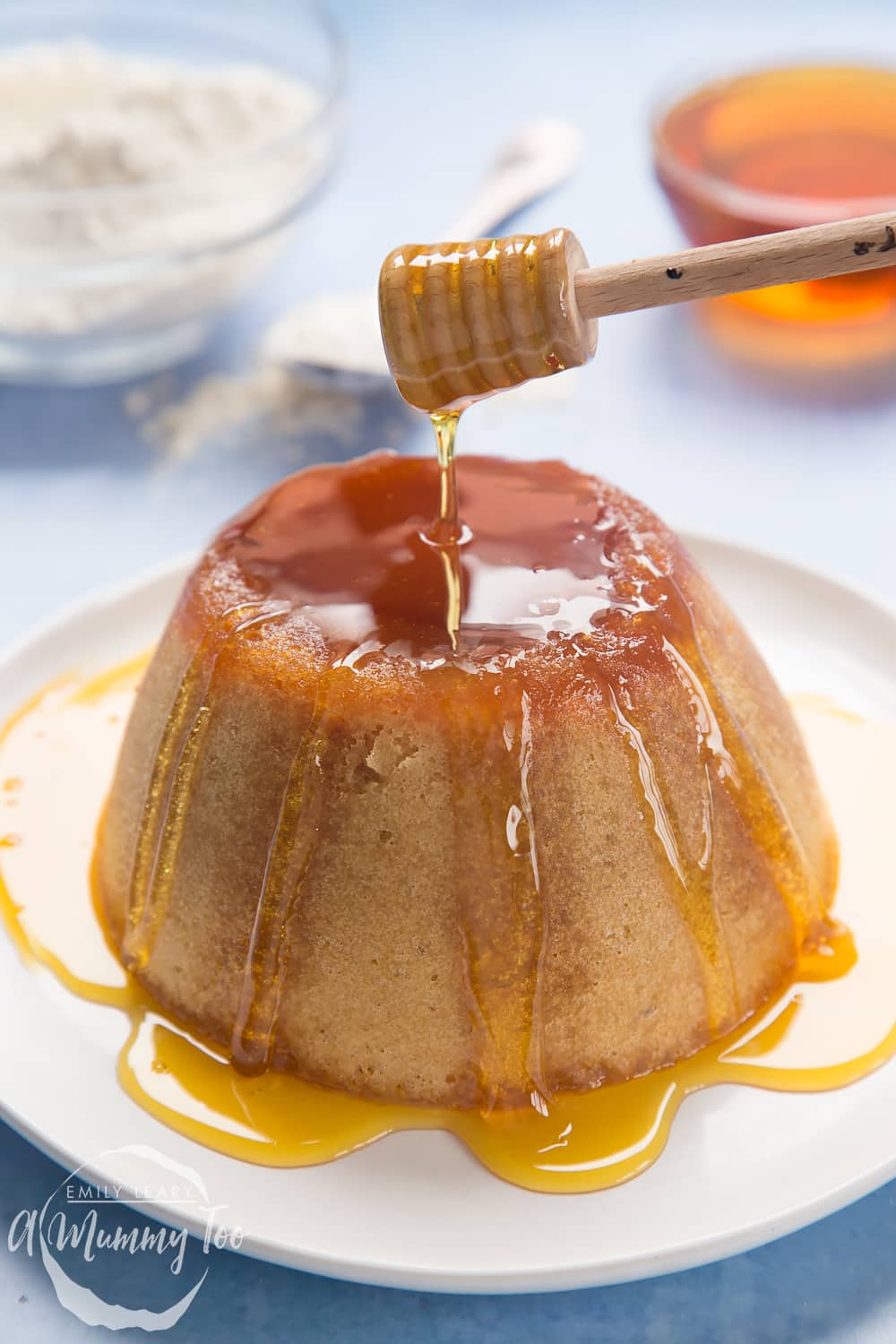
Our microwave syrup sponge pudding was moist, sweet, soft and moreish.
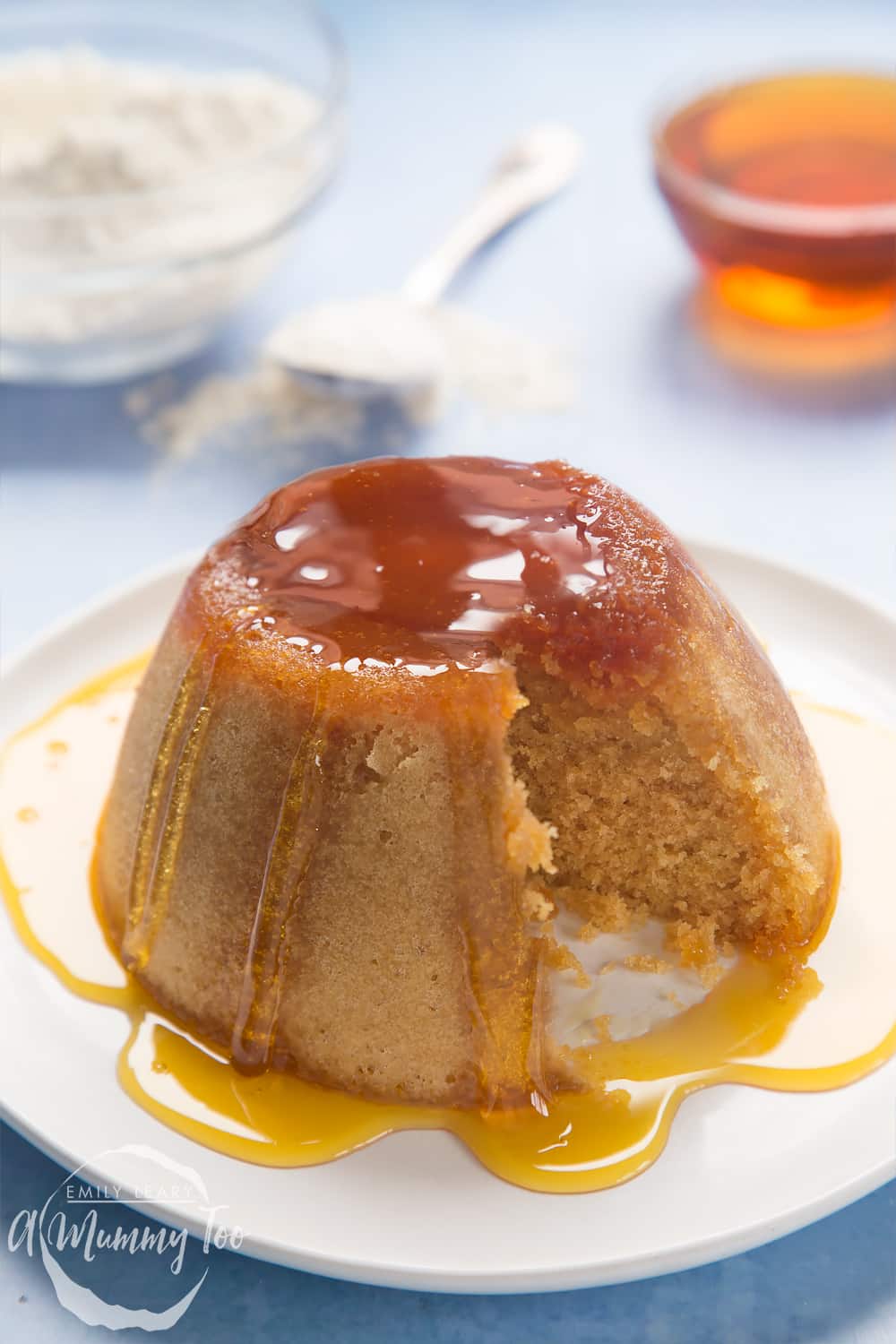
This recipe feeds four to six from a 1.5 pint pudding basin.
It takes about 10 minutes tops to make and uses ingredients you probably already have in the cupboard.
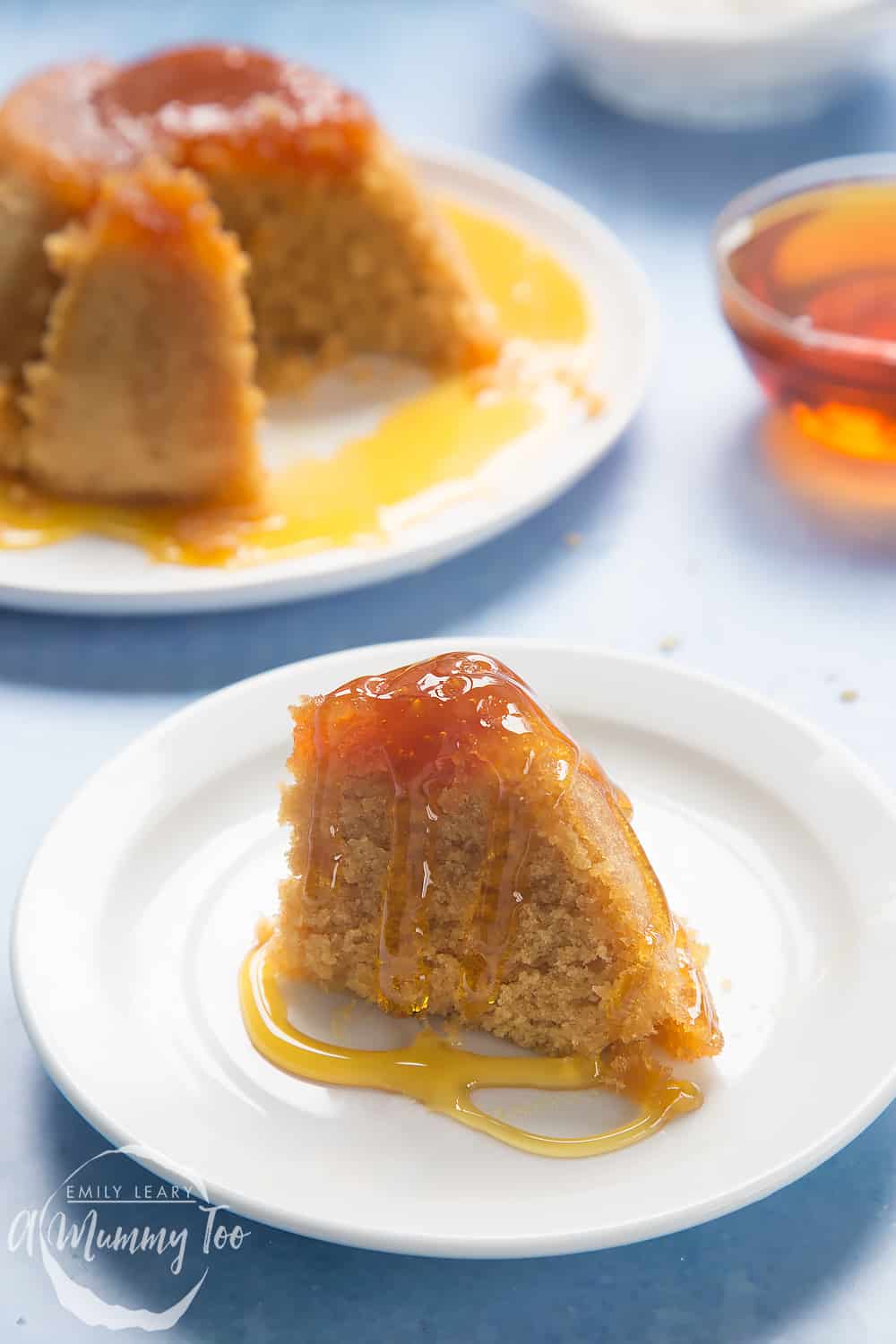
Ingredients
- 100 g (7 tbsp) slightly salted butter softened
- 100 g (½ cup + 2 tsp) white caster sugar (superfine sugar)
- 1 tsp vanilla extract
- 1 tsp black treacle (molasses)
- 1 medium free range eggs
- 100 g (¾ cup) plain white flour (all purpose flour)
- 1 tsp baking powder
- 60 ml (¼ cup) golden syrup
Instructions
Put the sugar and butter in a mixing bowl.
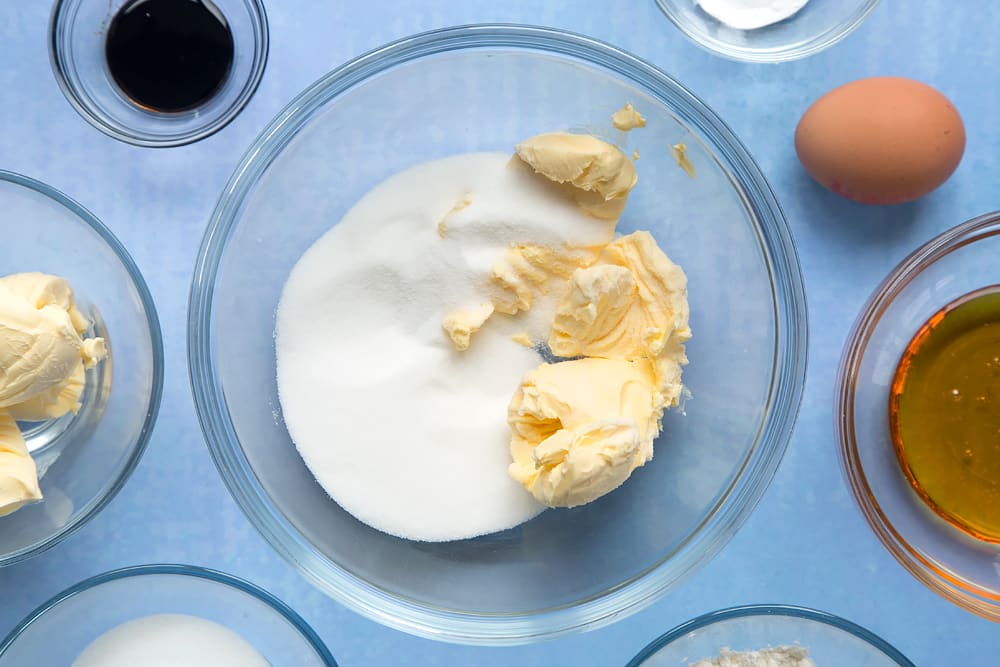
Whisk together until light and fluffy.
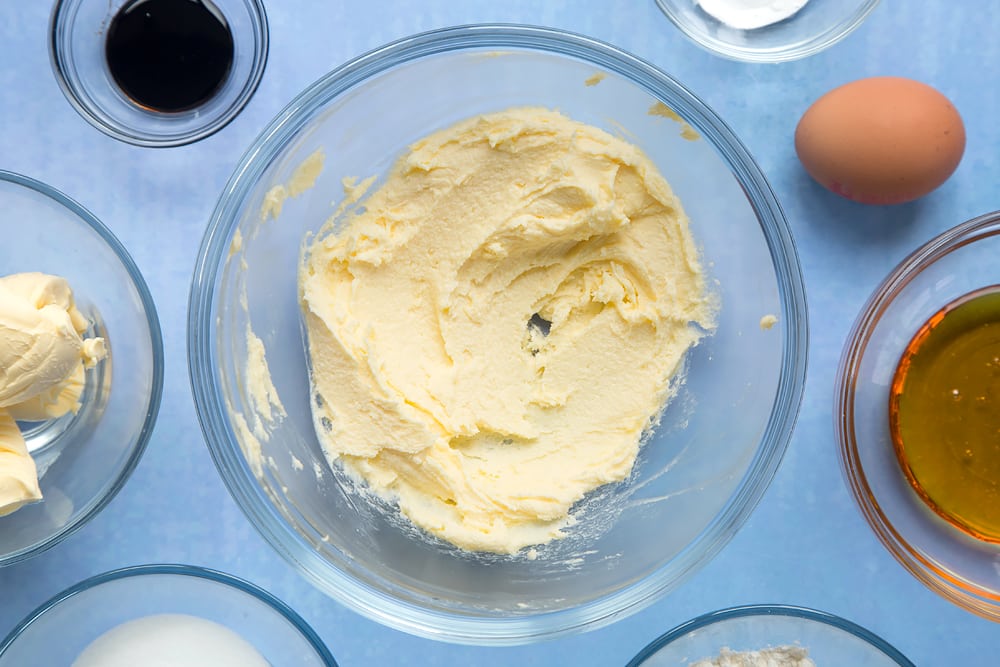
Whisk in the egg.
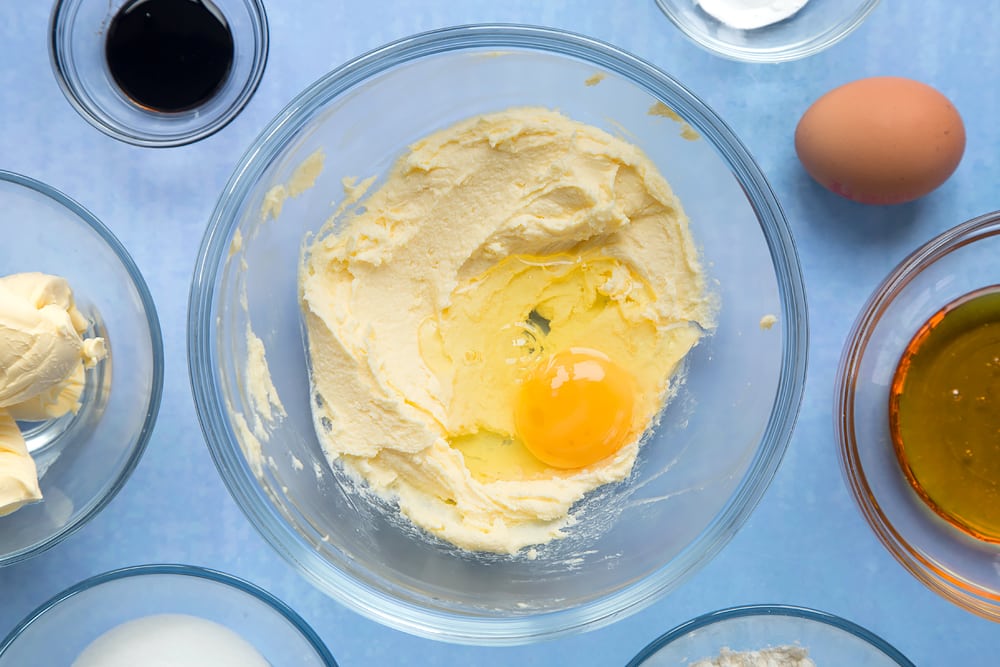
Add the vanilla and black treacle.
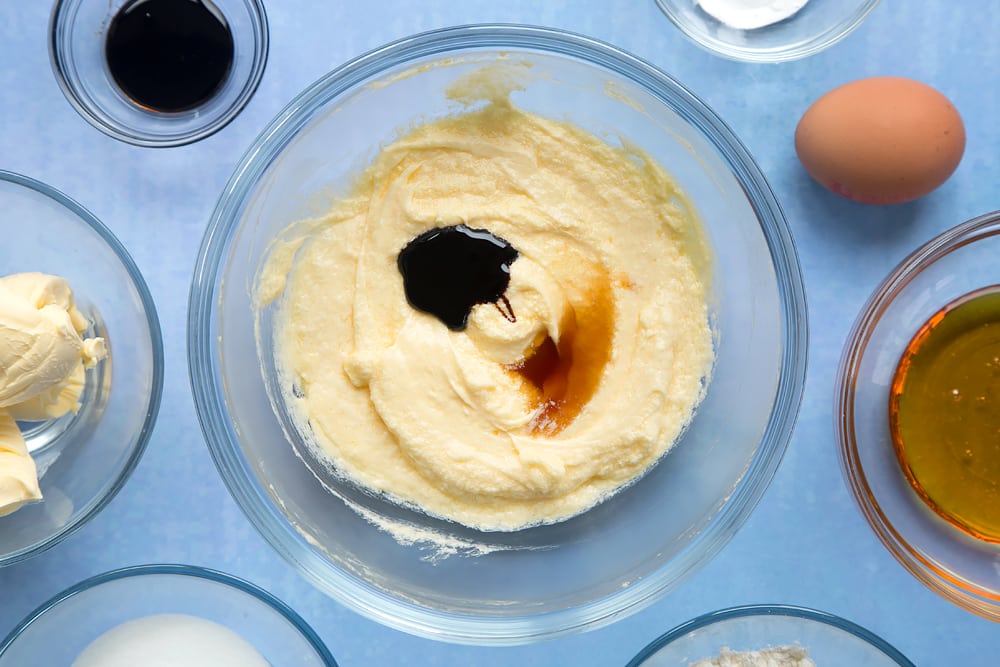
Whisk through.
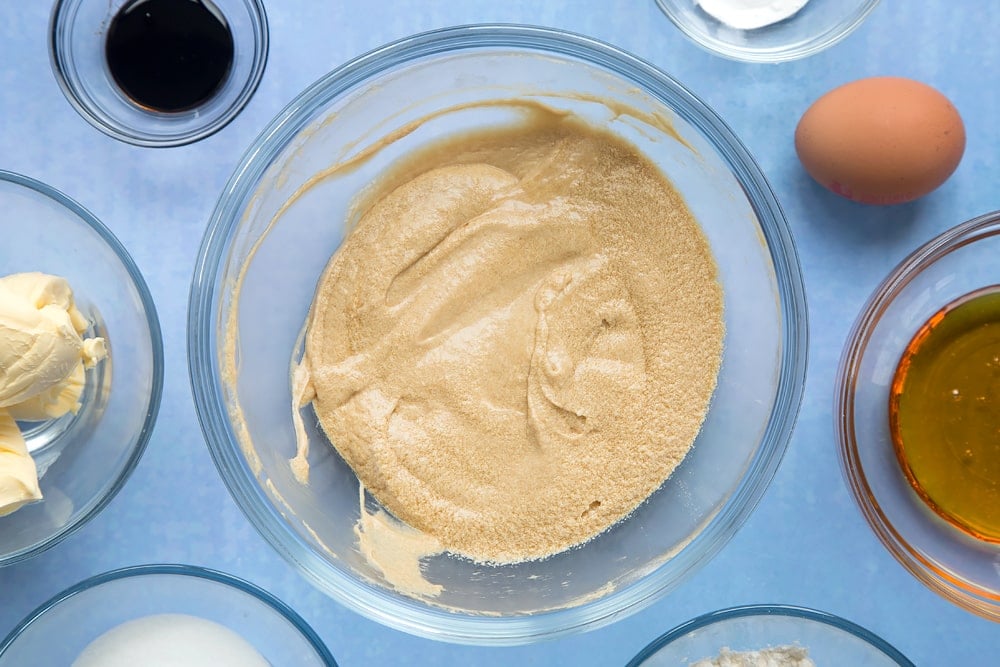
Add the flour and baking powder.
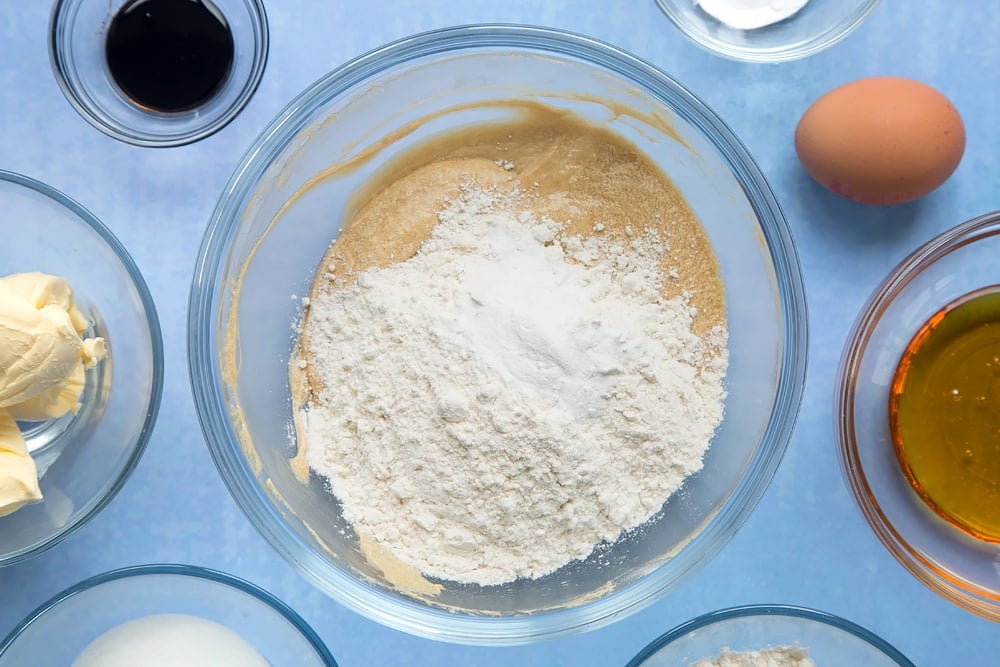
Fold through.
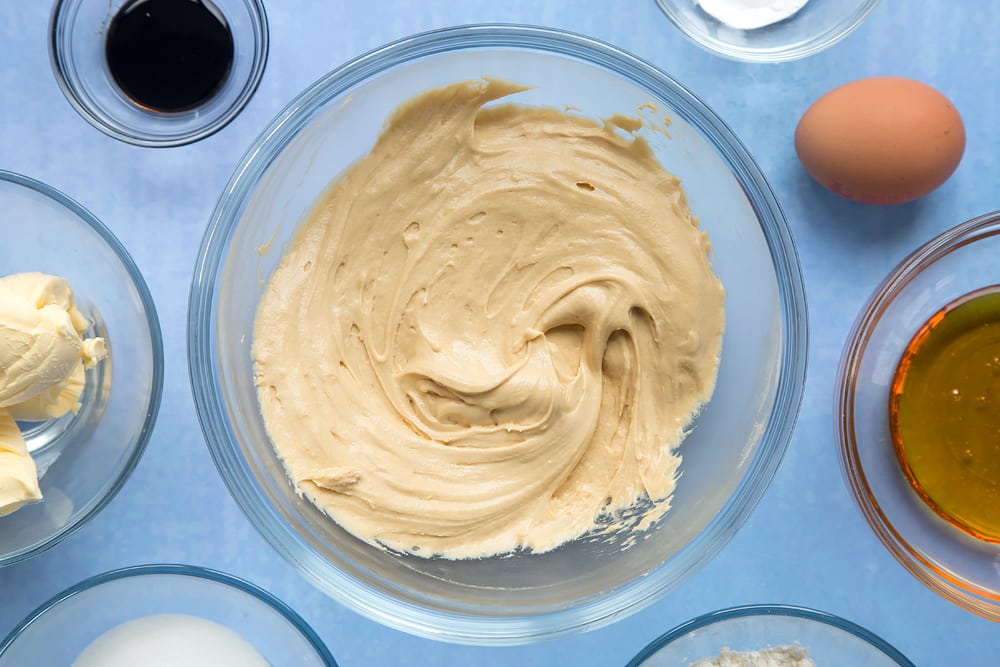
Grease a 1.5 pint plastic pudding basin. Pour half of the golden syrup into the bottom of the basin.
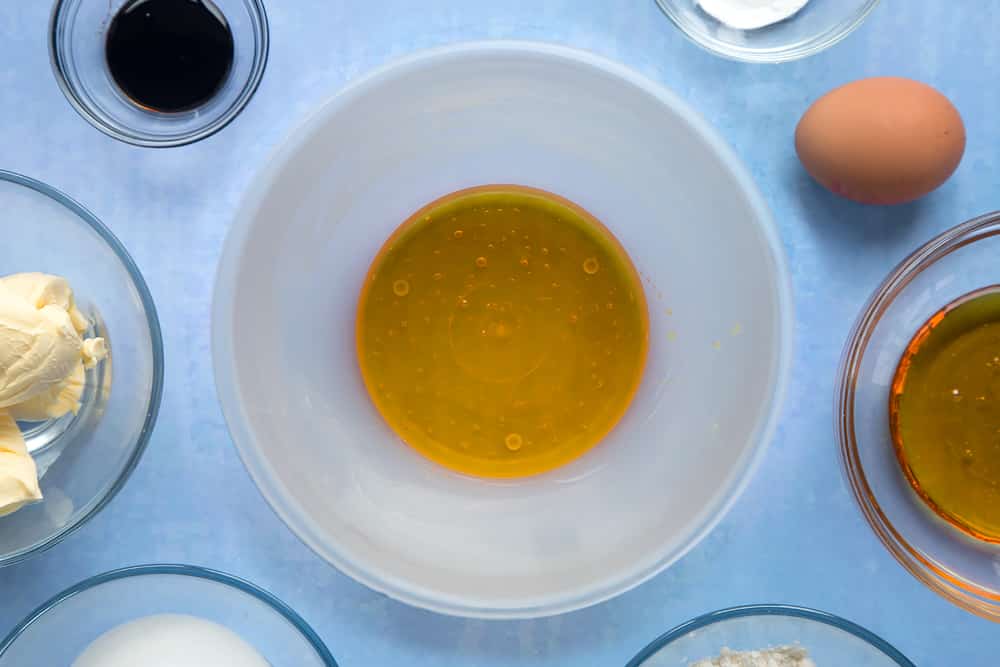
Carefully spoon the cake mix on top.
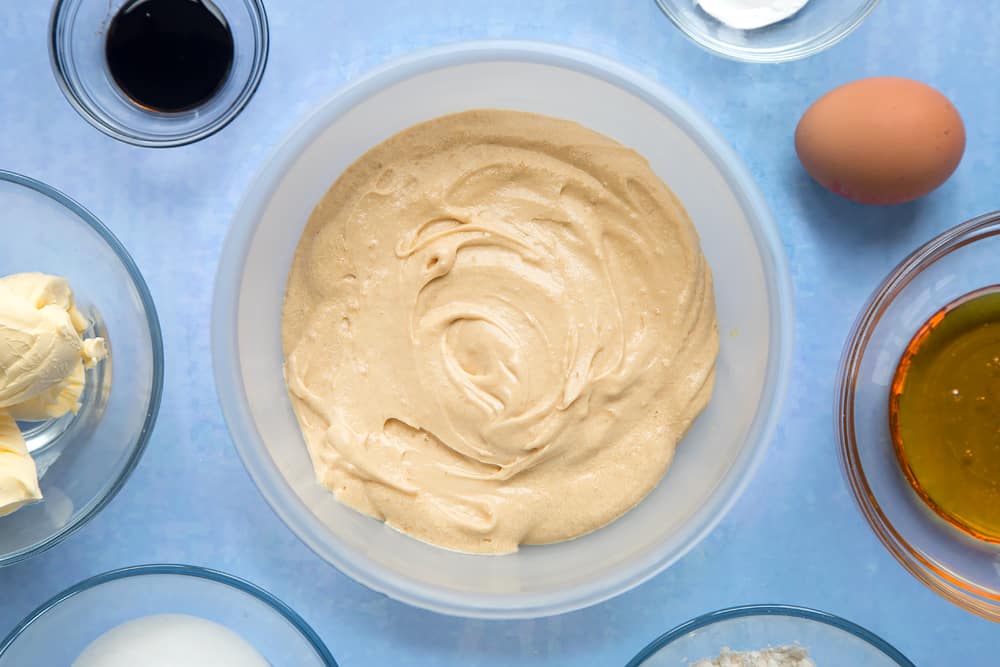
Microwave on high for 4-5 minutes.
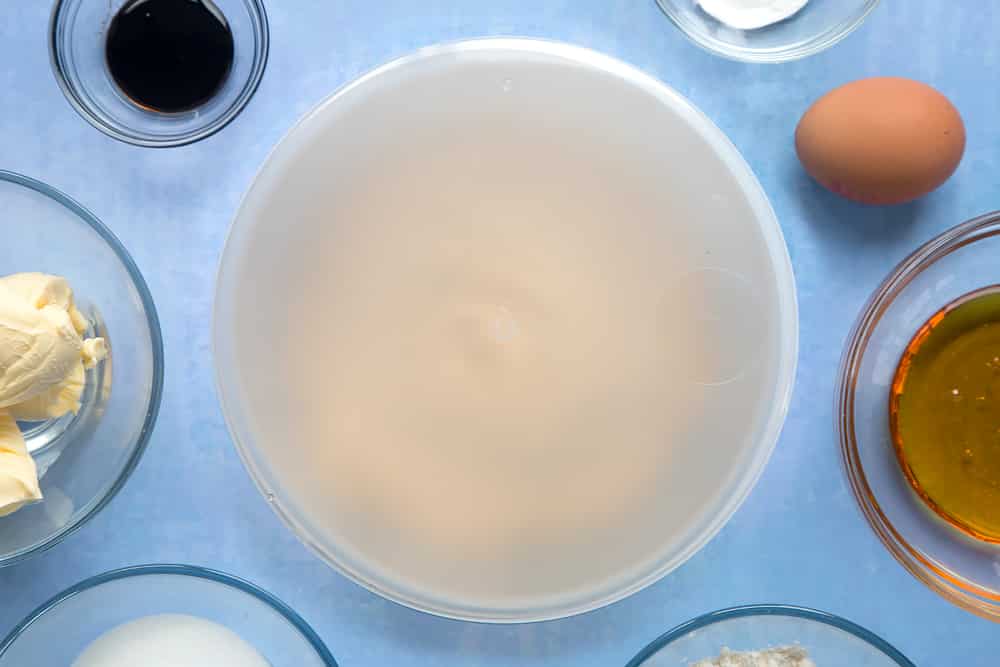
Leave to stand for 1 minute. Carefully, remove the lid - there may be steam.
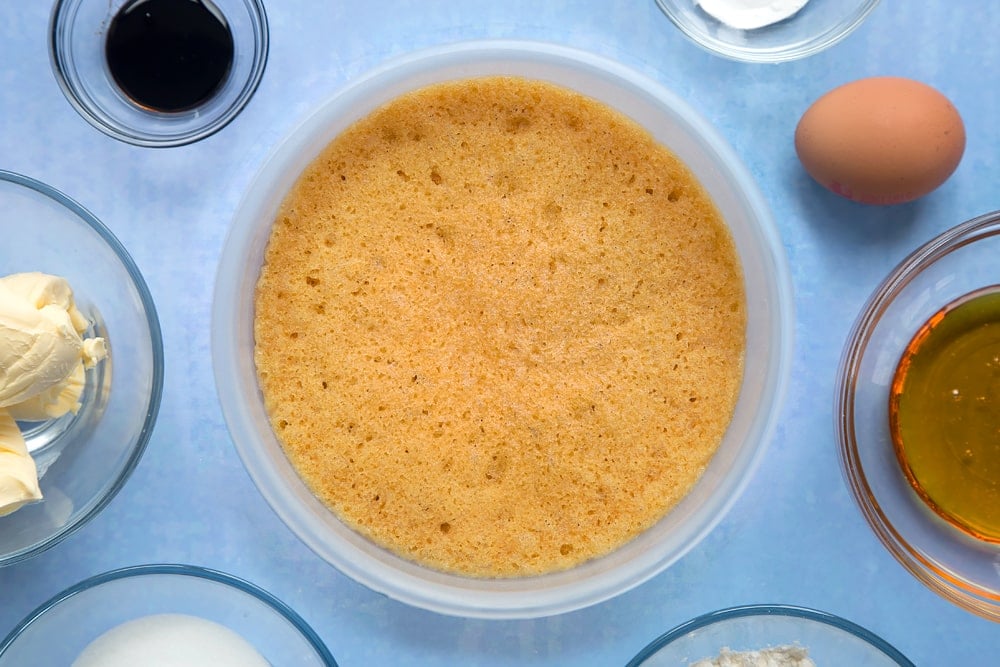
Turn the pudding out onto a plate - it will be very hot.
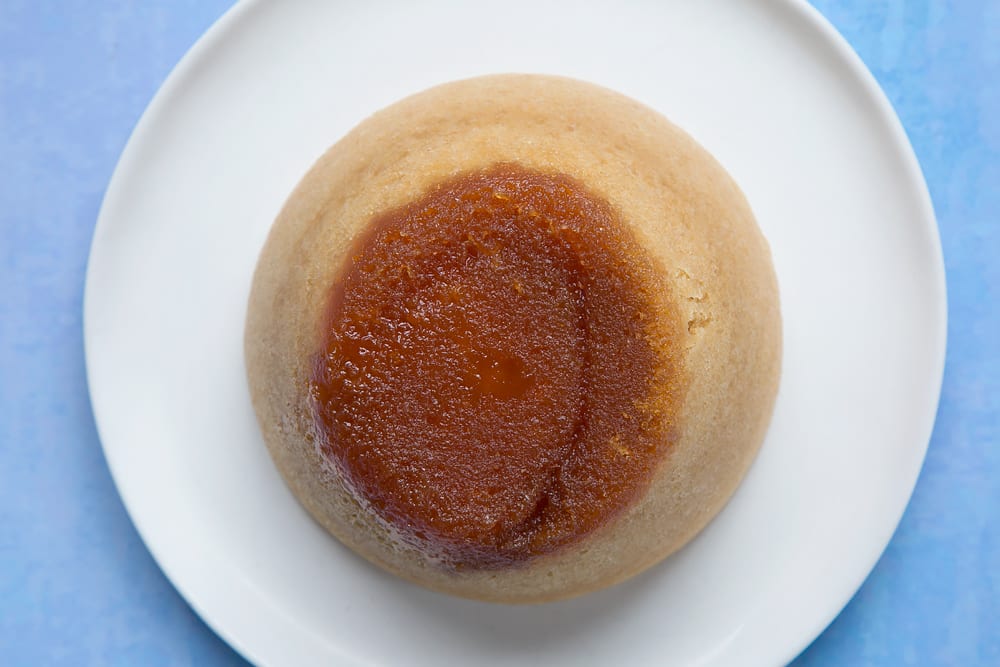
Drizzle with the remaining syrup and serve.
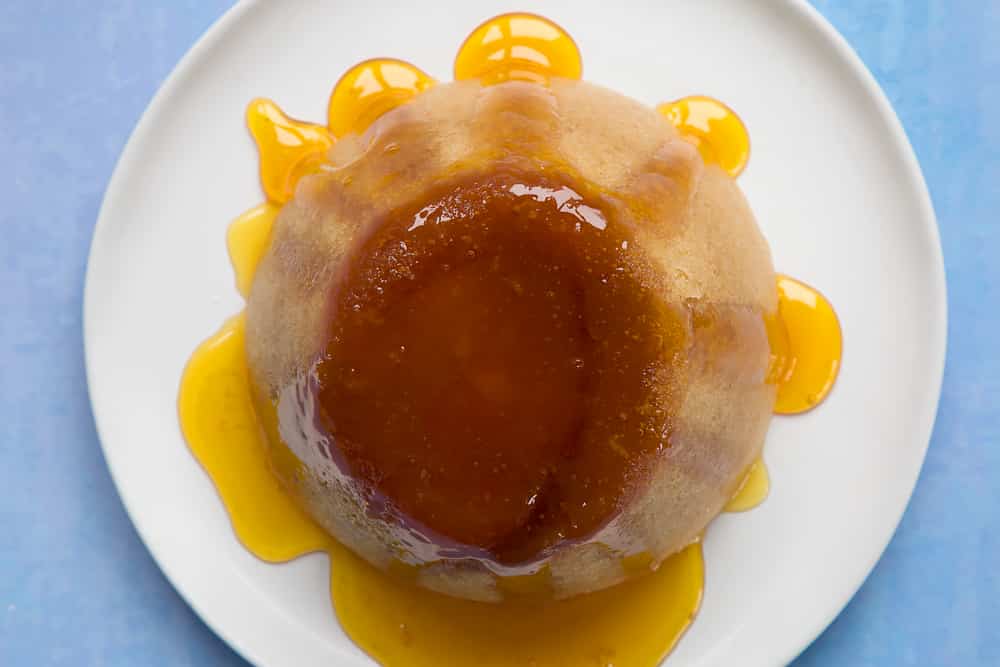
Beautiful, right?
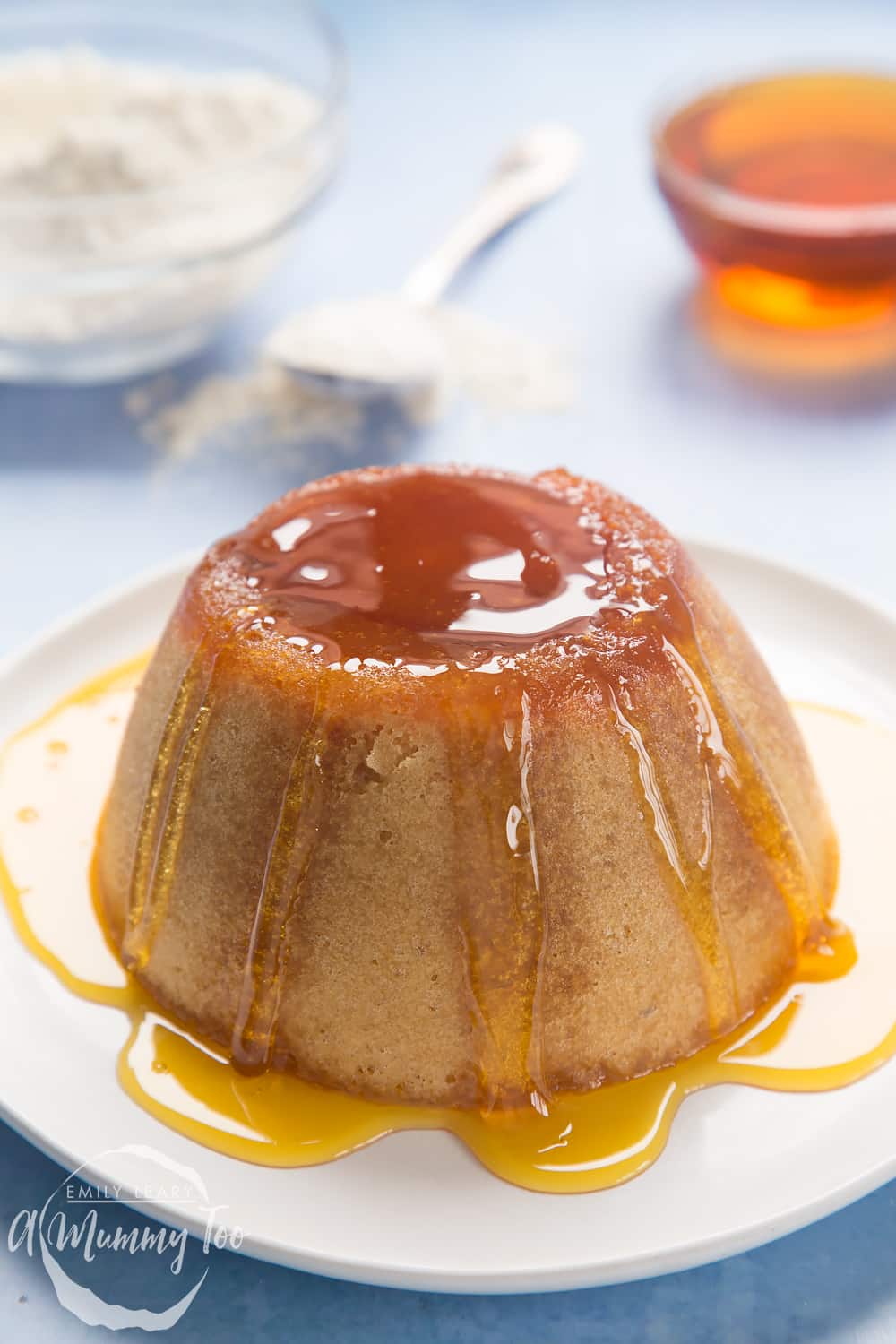
Serve with cream, ice cream, custard or simply extra syrup. Oh, so good. What will you serve with yours?
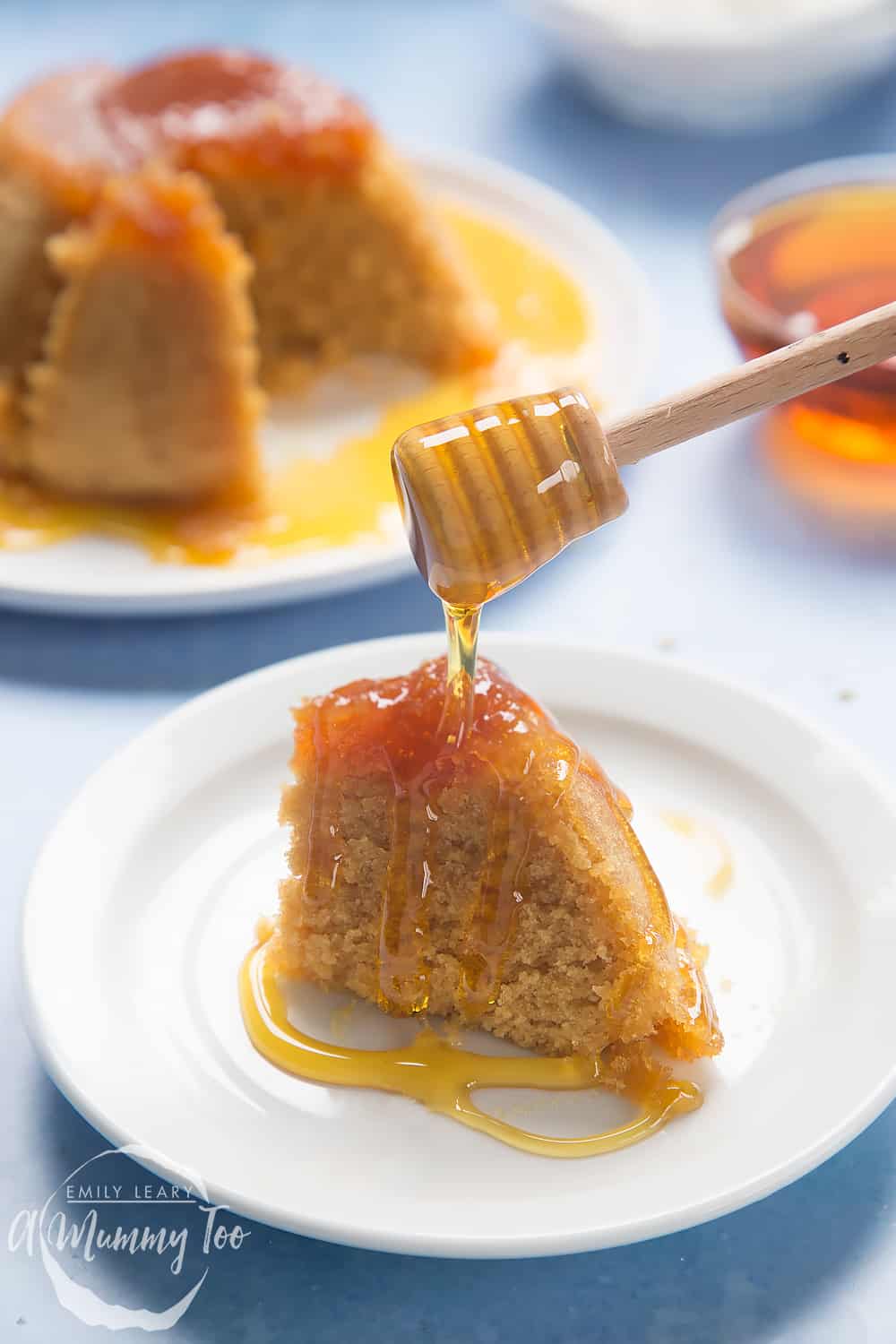
Pointers, tricks and troubleshooting tips for the perfect Microwave syrup sponge pudding
Is Microwave syrup sponge pudding easy to make?
This is probably one of the easiest websites on the site! It takes 10 minutes to make and uses ingredients you probably have in the back of your cupboard.
All you do is mix the ingredients in the order the recipe states, pour the mix into a lidded pudding basin and cook for 5 minutes! Let it rest, pour over the remaining golden syrup and you’re ready to dig in! Simple!
As ever, this recipe has step by step pictures. So you can see exactly how your sponge mix should look as you go along.
For extra help, I've answered some common questions in the section below - I hope it helps!
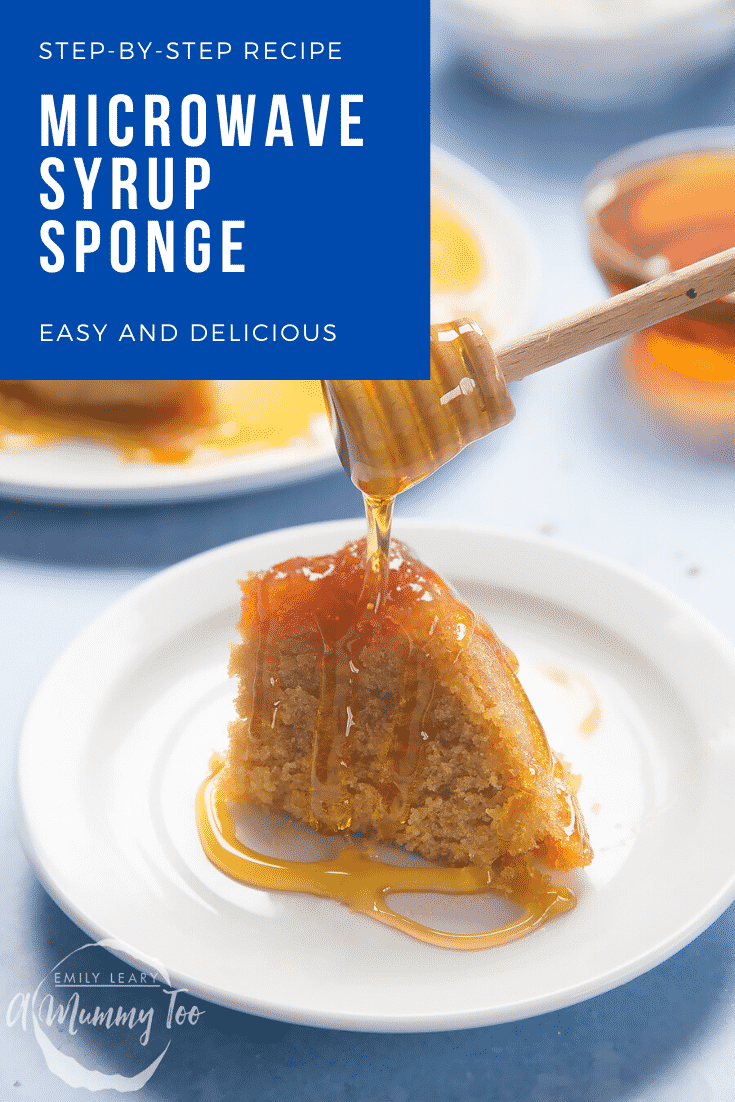
Will I need any special equipment to make Microwave syrup sponge pudding?
The only equipment you might not have is a 1.5 litre pudding basin. A pudding basin is a good bit of kit to have in your kitchen, as you can use it for making so many classic British desserts (including Christmas pudding).
The best place to look for a pudding basin is a kitchenware store like Lakeland or a department store like John Lewis (UK). Or if you’re outside the UK, pudding basins are available from Amazon in various sizes.
I used a plastic/silicone pudding basin for this recipe, but a lidded ceramic (microwave safe) pudding basin should work too. However, using a ceramic basin may affect the cooking time.
There's always a complete list of suggested equipment on the recipe card below my recipes if you're in doubt. In addition, I always include links to example products, to show exactly what I used to make each recipe.
What is molasses?
Molasses is a thick, dark syrup that forms during the sugar-making process. It is made from the residue leftover after cane sugar is boiled. Molasses is thicker and darker than treacle, but they’re similar in taste and work similarly in cooking.
Molasses has a deep, slightly bitter sweetness so it can be used for many purposes from baking to making marinades for barbecued meats. The slight bitterness means it is less outwardly sweet than honey, despite being a sugar syrup. However, the bitterness is very subtle and I think it has a lovely comforting, cosy flavour.
Where can I buy molasses?
Molasses (sometimes known as Bootstrap molasses) is very common in the US, so you’ll probably find it in a supermarket if you live stateside.
In the UK, molasses is sold at health food stores like Holland and Barrett. This is because molasses is rich in antioxidants, iron, calcium, magnesium, potassium, phosphorus, and vitamin B6. These nutrients are produced by chemical changes occuring throughout the multiple stages of boiling and cooking.
Don’t worry, if you can’t find Molasses in store - you can usually find it on Amazon too.
What can I use instead of dark treacle/ molasses?
If you can’t find dark treacle or molasses, you can use the same quantity of golden syrup or honey.
However, molasses is “hygroscopic”, which means it attracts moisture and gives a rich, almost fudgy texture to bakes. So golden syrup would work better than honey as a replacement, as it’s the closest in taste to molasses and treacle - though the texture might be a little different.
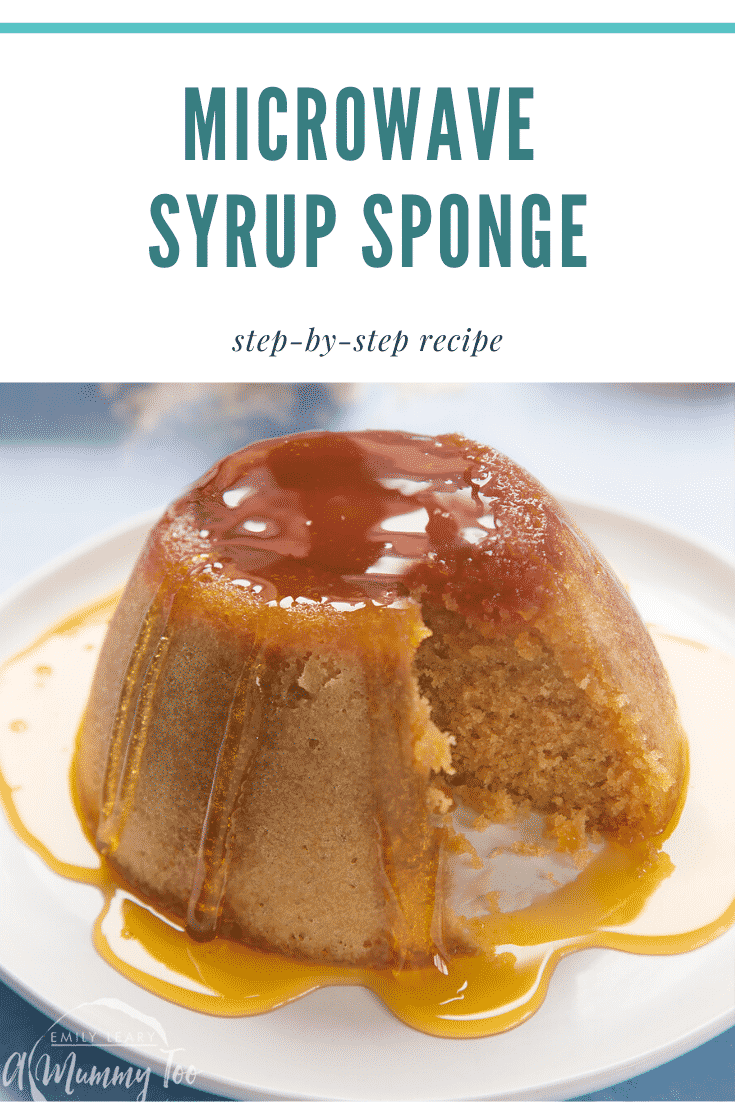
How can I tell if eggs have gone off?
It's always best to use fresh ingredients when baking, especially eggs. This is because eggs lose water content the older they get, which means an older egg will be thicker. So not only is it safer to use fresh eggs, but it will improve the quality of your food.
When older eggs lose their water content, the space is filled with gas either absorbed through the shell or produced when bacteria break down the egg contents.
The presence of gas means you can test if your egg is fresh by dropping it into a cup of water. If it floats, it is definitely spoiled. However, some bad eggs can still sink.
So to ensure you don't contaminate a recipe with a bad egg, it's always best to crack your eggs into a separate bowl or cup before adding them to a recipe.
You should never eat an egg that looks, smells, feels or tastes odd in any way. So if your egg has any discolouration, odd appearance, or a strange or foul odour, it is most likely rotten.
If your egg has spoiled, you should immediately throw it away and thoroughly wash any pots and utensils that have come into contact with it.
To avoid your eggs spoiling, you should always follow the storage instructions on the egg packet. In the UK, it's recommended that eggs are kept consistently below 20C, which means it's best to keep them in the fridge at home.
In the UK, you can eat a runny, semi cooked or even raw egg if it is produced to British Lion standards. Any egg stamped with the British Lion symbol comes from hens vaccinated against salmonella, and is produced in a heavily regulated environment. So if you’re in the UK, try and buy British Lion eggs for the safest option.
This only applies to British eggs, so consult your local advice on egg safety if you’re outside the UK.
Egg safety is crucial if you're cooking for someone in a vulnerable or at-risk group, such as older people, people living with health conditions, or a pregnant person.
A Mummy Too does not give medical advice. Please consult with your medical professional.
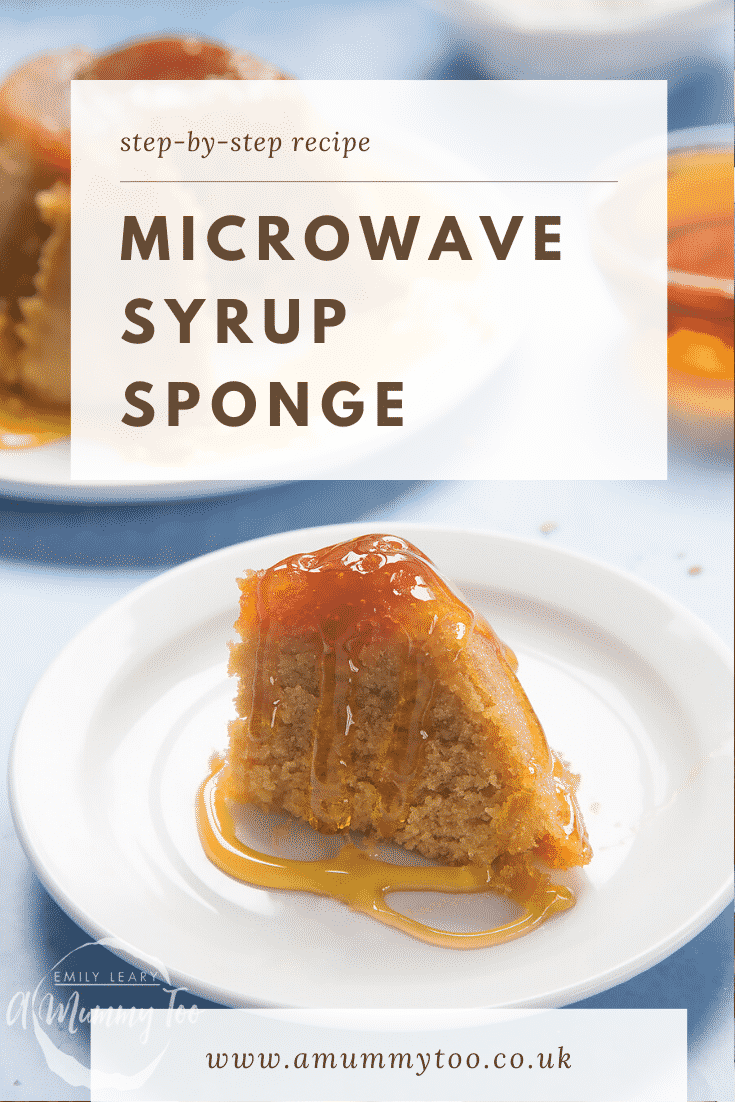
How can I tell if butter has gone off?
If your butter is fresh, it will be a cream or pale yellow colour. Your butter should only have a delicious buttery smell - it shouldn’t smell sour. So it's usually easy to tell if your butter has spoiled as soon as you open the packet.
When butter spoils, it turns dark yellow with translucent patches. This occurs when bacteria begins to break down the butter. This process also causes the butter to smell sour or rancid, as lactic acid is released.
Another sign butter is off is if it has mould growing on it. Butter is unlikely to develop mould if you keep it clean and sealed. Mould will grow on butter if any crumbs from a knife, or other contaminants, get into it.
So if your butter has any of these signs, you should discard it immediately. You should also make sure to wash anything spoiled butter has come into contact with.
Sometimes spoiled butter can seem completely fine. So if your butter is older, give it a taste to check it’s safe to use. If it tastes sour or rancid, throw it out.
Is Microwave syrup sponge pudding suitable for vegetarians?
Yes, this recipe is completely vegetarian! Yay!
Always make sure that you double-check all of your ingredients labels to ensure that they are vegetarian. Also, don't forget to check anything extra that you intend to serve with your recipe.
Is Microwave syrup sponge pudding suitable for vegans?
Unfortunately, this recipe is not suitable for vegans, as it contains eggs and dairy. However, only two ingredients are non-vegan, so you could try to adapt the recipe.
First, you could substitute the eggs for a vegan egg replacer. I often use chia seeds or flax seeds as directed below. However, I think aquafaba or a powdered prepared egg replacement would work best for this recipe as you won’t end up with bits of seeds.
Each of these options makes the equivalent of 1 egg, so choose one, not all of them!
- 3 tablespoons of aquafaba. Aquafaba is the water you get in a tin of chickpeas, and no, it doesn't taste like chickpeas!
- 1 tablespoon of crushed chia seeds or flax seeds mixed with 2 tablespoons of water and left for 10 minutes in the fridge.
- 3 tablespoons of applesauce (bear in mind this will add sweetness and potentially an apple flavour).
The only other non-vegan ingredient is butter. Luckily, most supermarkets sell plant-based butter in refrigerated aisles.
You should use vegan butter with a fat content of around 80% so that it behaves similarly to dairy butter when it's mixed and cooked. Fat content is especially important for a microwave cake, as the way the oil heats is key to the cake rising.
Many brands available worldwide offer good quality vegan alternatives to butter, including Naturli and Violife. Though, I mainly use unsalted Flora vegan butter in vegan baking because it performs well and they make a salted and unsalted version.
Animal-derived products can sneak into the most surprising ingredients! So always check your ingredients labels to ensure that they are vegan. Also, don't forget to check anything extra that you intend to serve with your Microwave sponge syrup pudding.
Is Microwave syrup sponge pudding gluten-free?
This recipe contains wheat flour, so it isn’t gluten-free, but luckily it should be fairly easy to adapt to a gluten-free diet.
All you need to do is swap the plain flour for a plain gluten-free flour blend. It’s best to use a blend of different flours which contain stabilisers/starches to replicate the behaviour of gluten. I find this plain gluten-free flour from The Free From Fairy works really well in sponges. However, Doves Farm is a more widely available brand and it would work just as well.
Sometimes baking powder can contain gluten, so make sure you get a gluten-free version too!
Double-check all of your ingredients labels to make sure that they are gluten-free. Some ingredients can contain trace elements of gluten or cross-contamination warnings. So if you’re cooking for someone with a severe allergy, make sure you’re extra careful.
Is Microwave syrup sponge pudding keto-friendly?
This recipe contains a high amount of sugar and carbohydrates, so it isn't ideal for a keto diet. A ketogenic diet limits the amount of sugar and carbohydrates you consume to around 20g per day, to regulate your GI/ blood sugar levels. So if you had some Microwave syrup sponge pudding it could push you over that limit.
Is Microwave syrup sponge pudding healthy?
This recipe contains a fair amount of sugar, so while it’s easy to whip up when you fancy, it’s definitely not a healthy snack.
However, there’s nothing wrong with a treat - especially on a rainy day!
Is Microwave syrup sponge pudding safe to eat while pregnant?
As long as you use fresh ingredients and clean ingredients and cook the sponge pudding safely, there’s nothing in this recipe that would be unsafe for a pregnancy.
However, this pudding is quite sugary. Pregnant people can be more sensitive to changes in blood sugar, so that's something to watch out for if you or your loved one is pregnant.
A Mummy Too does not offer medical advice. Please seek help from a medical professional if you need further information or have any concerns.
What goes well with Microwave syrup sponge pudding?
This recipe would be perfect with a scoop of vanilla ice cream on top. The contrast of the warm sponge and the cold ice cream is a match made in heaven! Or if you don’t have any ice cream, double or single cream would do.
Can I use granulated sugar instead of caster sugar?
You can use granulated sugar if you don't have any caster sugar, but it might not dissolve into the mix as well as caster sugar. You could blitz your granulated sugar in a power blender to make it finer. Though it’s not the end of the world if you don’t use caster sugar for this recipe as it’s a little more forgiving than an oven-baked cake.
Does it matter if I use baking margarine or butter in the sponges?
Butter and margarine both work well in sponges, but they do produce different results. In the oven, margarine produces lighter sponges and helps them bake evenly. Though butter gives cakes a better colour and richer flavour.
If you use margarine, you should use one with high-fat content. Margarine with lower fat contains more water, which can cause the texture of the sponge to turn mushy or impact the formation of the sponge texture.
Some cooks feel that margarine works better in a microwave cake recipe, as margarine is usually oil-based. So the oil superheats faster, helping the sponge rise. However, too much oil can result in a rubbery sponge.
Good quality, high-fat margarine can produce a lighter sponge that rivals a butter-based sponge. However, I prefer butter for a richer flavour and texture.
Can I add extra chocolate to this recipe?
This recipe doesn’t have any chocolate in it, but if you’re craving a cocoa fix, you could add a teaspoon of cocoa powder to the batter.
Cocoa powder or hot chocolate powder is probably the safest way to add chocolate to this Microwave syrup sponge recipe. I’m not sure how chocolate chips would affect the batter when cooked in the microwave.
How should I store Microwave syrup sponge pudding?
The best way to store your Microwave syrup sponge pudding is to pop it into a sealed container in a cool dark place or in the fridge. You can freeze it too, as detailed below. However, I always prefer fresh microwave puddings, as they don’t keep as well as baked goods.
How long will Microwave syrup sponge pudding keep?
Your Microwave syrup sponge pudding should keep for up to 3 days in a sealed container. Though it only takes 10 minutes to make so it’s really best enjoyed fresh.
Can I leave Microwave syrup sponge pudding out on the counter?
No, this is a sweet and sticky sponge pudding, so if you leave it out on the counter it will attract all sorts of unwanted visitors (bugs). So it’s best to enjoy it fresh and keep any leftovers in a sealed container.
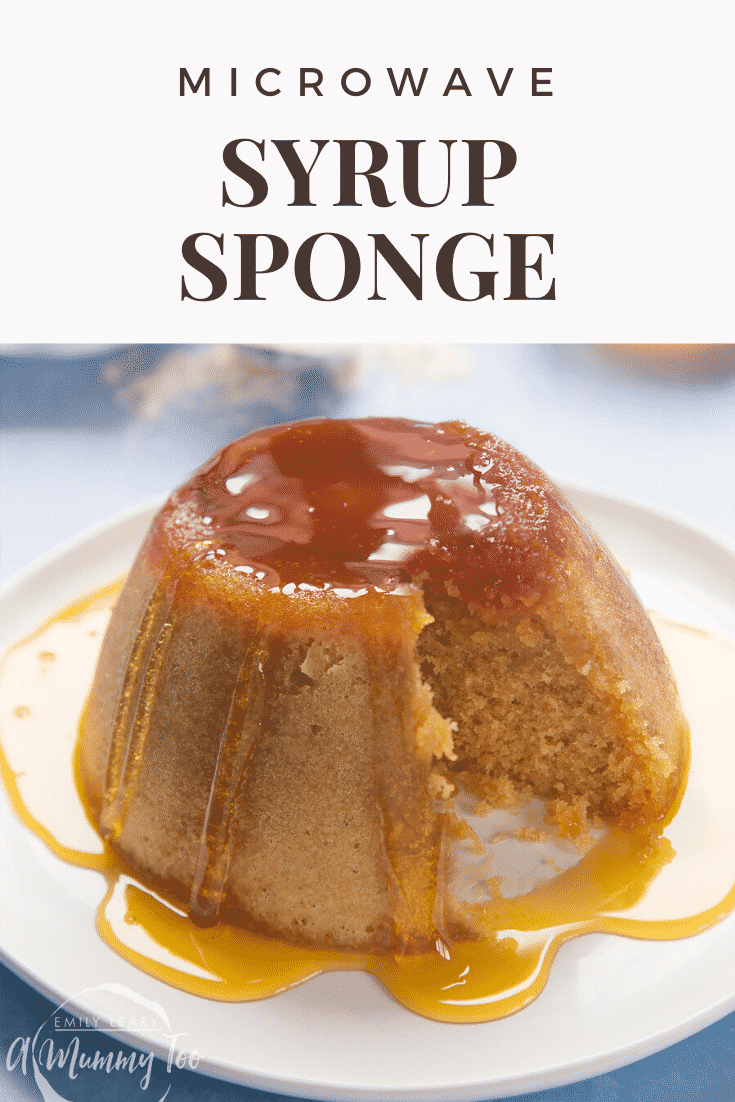
Can I make Microwave syrup sponge pudding ahead?
I would recommend making this Microwave syrup sponge pudding as you want to serve it. It only takes 5 minutes to prep and 5 minutes to cook, so it’s easy to fit into the busiest day. Plus, it’ll taste best still warm from the microwave. Though make sure to let it stand for a minute so you don't burn yourself!
Can I keep Microwave syrup sponge pudding in the refrigerator?
If you have any leftover portions, you can keep them in an airtight container or covered plate in the fridge.
Can I freeze and defrost Microwave syrup sponge pudding?
You can freeze this pudding if you like, but considering how little time it takes to prep and cook, I don't see much point! If you’re worried about leftovers you can adjust the recipe size using the information below so you don’t make a pudding which is too big.
If you do want to freeze your Microwave syrup sponge, treat it like a baked cake or pudding. Pop it into an airtight container and freeze it for up to 3 months.
To defrost, transfer the container to the fridge and leave it for 6 hours (if defrosting the full pudding) or a couple of hours (for one portion).
I’m not sure how the texture will turn out once it defrosts, as it’s quite moist, but you could microwave it for 15 seconds to reheat it and see how it turns out.
Can I make Microwave syrup sponge pudding in a different quantity?
If you want to make a smaller or bigger Microwave syrup sponge pudding, you can use an online recipe size converter to adjust the yield.
When using these calculators I find it best to test how accurate it is by converting one ingredient and manually working out the conversion size too, just in case there’s a website error.
If you change the size of the recipe, you’ll also need to change the size of the pudding basin and cooking time. This recipe uses a 1.5 litre pudding basin. So once you adjust the recipe size convert all of your ingredients to ml and see what the total is.
1 pint pudding basins are pretty common, and 1.7 British pints = 1 litre. So for a smaller pudding you could convert the ingredients to Imperial measurements and make a batter to fit a 1 pint pudding basin.
Can I make Microwave syrup sponge pudding in a stand mixer such as a KitchenAid or Kenwood Mixer?
This is a cosy, lazy day recipe, so a stand mixer would help you maintain the lazy mood by doing all the mixing for you!
You can use a stand mixer with a balloon whisk attachment to cream together the butter and sugar and to mix the wet ingredients together. Make sure to scrape down the sides of the bowl so you don’t end up leaving half of your ingredients clinging to the mixing bowl.
Once you add the flour and baking powder you should only gently fold it into your batter by hand. Otherwise, you might knock the air out of the mix and end up with a dense sponge.
Can I make Microwave syrup sponge pudding with a food processor?
A food processor would be too powerful for mixing your sponge mix. It would also be very fiddly to get all of the batter out after mixing. So save yourself the trouble and mix by hand or use a stand mixer.
How can I make sure my Microwave syrup sponge pudding turns out perfectly?
Microwave sponges are easy to get right, but if they overcook they can dry out quickly. So here are a few points to watch out for when cooking your Microwave syrup sponge pudding.
- Mixing your ingredients: Some microwave sponge recipes (and students at 2am) say that you don't need to completely mix the ingredients together. However, I prefer to make sure the ingredients are fully mixed to avoid biting into a pocket of dry flour! Just be sure that you don't overmix once you add the baking powder and the flour - or you could end up with a dense, unrisen cake.
- Mixing your ingredients (part 2): It’s easiest to use room temperature molasses or treacle for this recipe, as if it is very cold it will be tough to mix into the batter. If it’s winter, pop the jar/tin of molasses or treacle into a bowl of warm water to loosen it up a little.
- Microwave power: So if you have a high powered microwave you might want to reduce the cooking time or lower the wattage. Around 600 watts is ideal for this recipe.
- Keep it covered: Sometimes microwave sponges can dry out. The molasses/treacle in this recipe should help keep it moist, but to be safe, make sure to leave the pudding basin lid on while it rests.
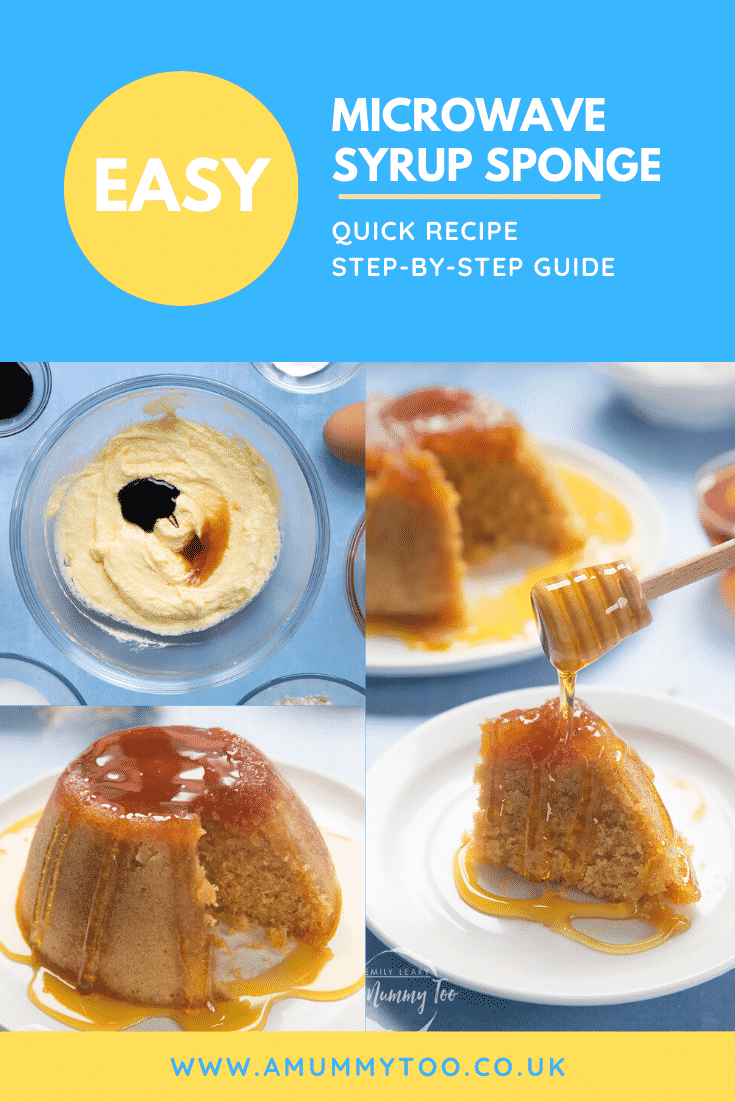
Why did my Microwave syrup sponge pudding turn out wet/flat/dense?
If your Microwave syrup sponge pudding is dense or wet, then there are three possible causes: it isn't cooked through, you forgot the raising agent, or you overmixed the batter.
If you added the right ingredients and mixed it as the recipe states you could try cooking it for another 15-30 seconds. However, this will only work if your sponge has risen.
However, you’ll have to start over if you forgot to add the raising agent, or you overmixed your flour and baking powder (leaving it unattended in a stand mixer is the usual cause).
Why did my Microwave syrup sponge pudding sink in the middle?
Microwave sponges usually rise evenly across the top, so if your sponge sinks in the middle it might be because the power is too high. This can cause the cake to rise rapidly and then collapse before the batter heats and sets into place.
However, this is unlikely as a regular microwave randomly zaps different areas of food with energy to cook it.
It may be because you have cooked your sponge in a convection microwave oven, which circulates heat in a different way from a regular microwave oven. Try using a regular microwave at around 600 watts and see if your sponge rises evenly.
How can I add the flavours to my Microwave syrup sponge pudding?
The best way to add flavours to this recipe is to use dry spices, citrus zest, or a few drops of flavour essence.
Cinnamon and nutmeg would work really well to compliment the earthy and mildly bitter flavour of the molasses. Or some orange zest would work well to cut through the sweetness of the golden syrup.
As I said above, you could add a teaspoon or two of cocoa powder for a chocolate syrup sponge.
Print this recipe
Want to make this microwave syrup sponge pudding at home? Click print below!
Microwave Syrup Sponge Pudding Recipe
Ingredients
- 100 g (7 tbsp) slightly salted butter softened
- 100 g (½ cup + 2 tsp) white caster sugar (superfine sugar)
- 1 tsp vanilla extract
- 1 tsp black treacle (molasses)
- 1 medium free range eggs
- 100 g (¾ cup) plain white flour (all purpose flour)
- 1 tsp baking powder
- 60 ml (¼ cup) golden syrup
Instructions
- Put the sugar and butter in a mixing bowl. Whisk together until light and fluffy.
- Add the egg, vanilla and black treacle. Whisk through.
- Fold in the flour and baking powder.
- Grease a 1.5 pint plastic pudding basin. Pour half of the golden syrup into the bottom of the basin.
- Carefully spoon the cake mix on top.
- Microwave on high for 4-5 minutes.
- Leave to stand for 1 minute. Carefully, remove the lid – there may be steam.
- Turn the pudding out onto a plate – it will be very hot.
- Drizzle with the remaining syrup and serve.
Video
Notes
Nutrition
Pin this microwave syrup sponge
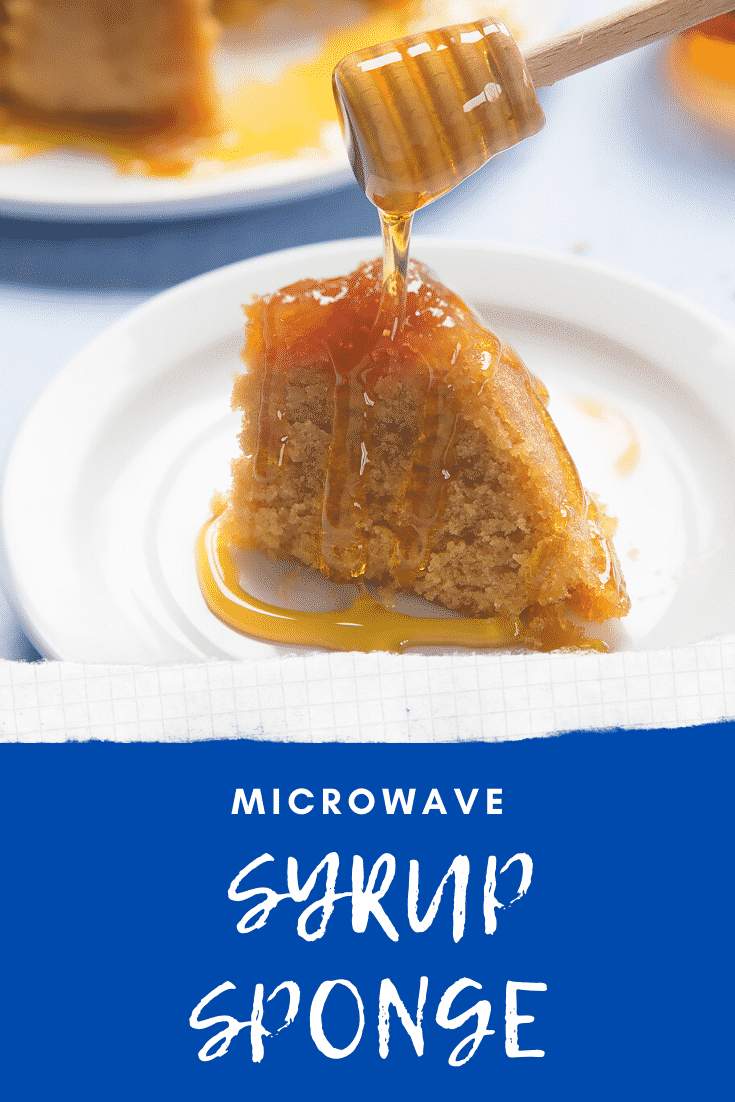
More delicious pudding recipes to try
If you enjoyed this microwave syrup sponge pudding, try these next!
Have you got my book?

'This is a great kids cookery book. Emily is a star' - Simon Rimmer
'The book I'd like to force into any mother's kitchen' - Prue Leith
"A fab book with a plan." - Jane Devonshire, 2016 Masterchef UK winner
'Emily has managed to combine her mummy knowledge and passion for food to make a truly helpful and brilliant cookbook' - Priya Tew, RD, BSc (Hons), Msc
Get Your Kids to Eat Anything is an achievable 'how to' for parents in the battle to overcome picky eating and 'make new the norm'. Emily Leary's unique 5-phase programme looks at the issue of 'fussy eating' in a holistic way that links imagination with food, and which situates parents alongside - not in opposition to - their children.
.

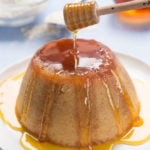
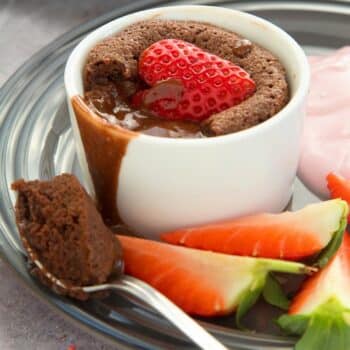

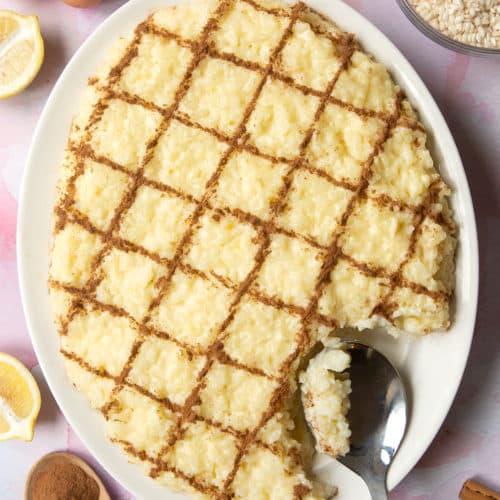
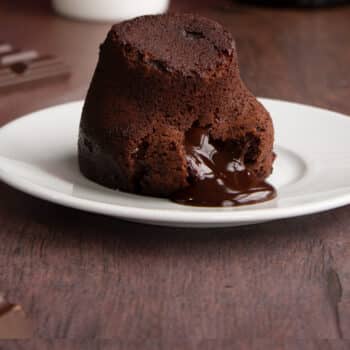
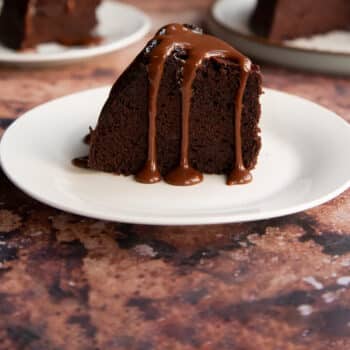
Carrie says
Really needed a sweet treat - this hit the spot! Thanks for the recipe. This Microwavable recipe is lovely :)
Emily Leary says
So glad you enjoyed it!
Patrick says
Turned out very heavy even after wisking well
Emily Leary says
The texture should not be dense in any way but bear in mind it's a syrup sponge pudding so it's not meant to be like a baked cake.
Ian Atkinson says
Tried the golden syrup microwave sponge .
Easy , the mixture was a bit dry so I added a table spoon of milk .
Microwave it for four minutes
Three good size bowls with custard
Very nice will make it again
Emily Leary says
Fabulous!
Kerrie @ Family Food and Travel says
Looks delicious! I love how easy it looks to make. Yummy!
I would love it if you came and linked this recipe up on Wednesday to Wonderful Food Wednesday on my blog - a great chance to introduce your recipes to new readers.
Following on G+
Kate says
Believe it or not, I don't have a microwave. This is reason #19494948 why i should get one!
Stopping by from the blog hop!
Romanianmum says
Now I really want to have a microwave! Yum!
HB says
Hi, I was just wondering if you meant golden syrup rather than treacle for the bottom in point no. 6? Thanks!
Emily (@amummytoo) says
Oops yes I do mean the golden syrup - will correct. Thanks for the message!
Mummypinkwellies says
That sounds lush, and easy too! Must try. One quick query though, point 6 of the method is that the golden syrup you put in the bottom? Thanks Emily xXx
Emily (@amummytoo) says
Oops yes I do mean the golden syrup - will correct. Thanks!
HELEN says
that looks lovely!
I think all the best recipes are made up as we go along, but thankfully now we write them down in our blogs so that we know how to make them again!
x
Emma @mummymummymum says
Emily, you are just too good :-)